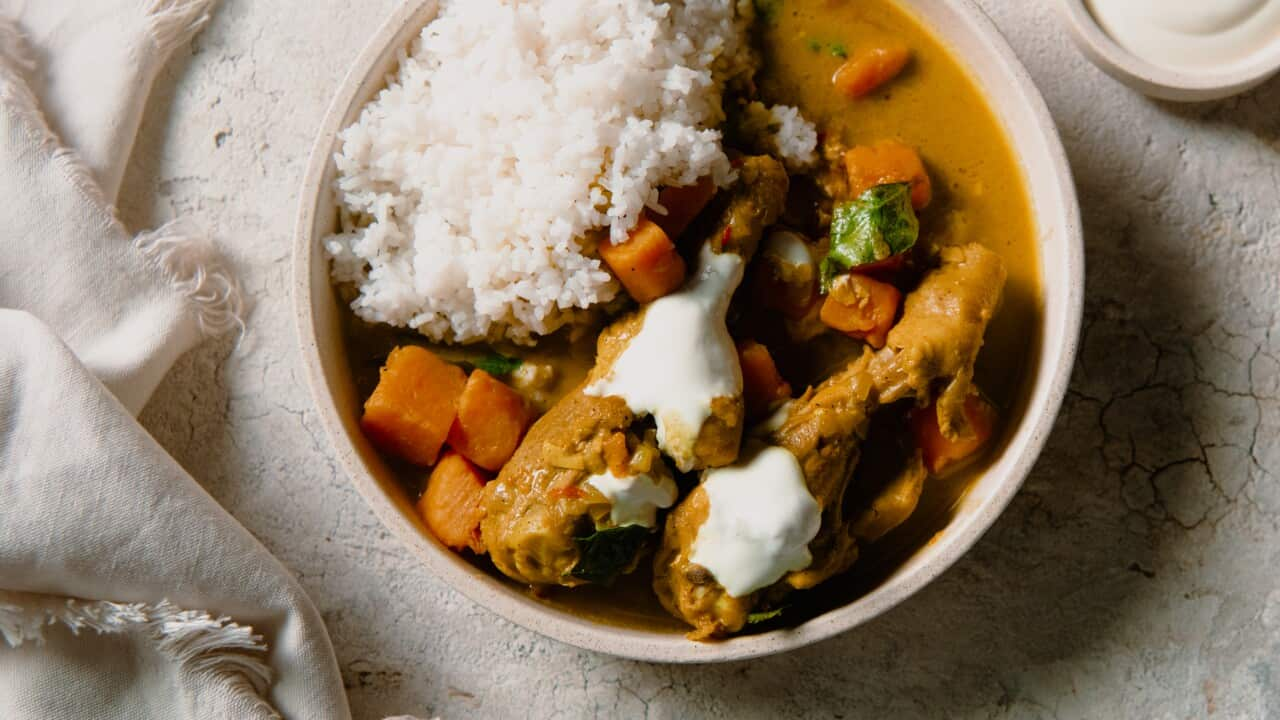When Indigenous comedian was a young boy growing up in Townsville (QLD), his mum would exit her home kitchen and issue a commanding whistle into the expanse of the backyard. The nightly sound signalled that a wholesome family meal was about to adorn the Choolburra dinner table.
“The kids would come running from the football field and back to our house to eat dinner whenever we heard mum’s whistle,” Choolburra tells SBS.
The 55-year-old comedian nostalgically appreciates the humble curries and soups his mum used to make for this family of eight. Although the food was simple, it was special.
As a kid, he didn’t realise it. Innocently, a young Choolburra thought that everyone across Australia ate the same meals he did, whether that was a chicken or sea turtle curry.
“I lived down the road from my best mate who was an Islander boy,” he says. “His dad would go turtle hunting and give my family turtle to eat all the time. Sometimes, we’d get so much of that turtle that we’d say ‘mum, we just want to eat cornflakes tonight’!”
In Queensland, hunting local animals like dugong and turtle is an important way of traditional life for Indigenous peoples. , dugong and turtle may be ethically hunted for reasonable traditional purposes. For thousands of years, native animal meats have been a major source of protein in Indigenous diets.
As Choolburra recalls, sea turtle, kangaroo, crayfish, dugong or fish were always served with rice. “We ate so much rice, we thought we invented it! Indigenous food north [of the Tropic of Capricorn in Australia] is very much influenced by Asia. So we ate rice with everything.”
READ MORE

Chicken and sweet potato curry
Remember when..?
Back then, Choolburra says, condiments were limited but always put to good use. “We had salt and pepper, tomato sauce and barbecue sauce. That was it. There was chicken salt but that was a luxury.”
Then, there was the iconic food product, bully beef – salt-cured, finely minced corned beef encased in a small amount of gelatin within a tin.
“Bully beef was the Aussie battler’s food and it became our food. We took it on and it became an Indigenous food.”
The processed meat product, which became popular in struggling Australian communities after World War One, is also popular across .
“We always had it with rice. As a joke, I once did a reggae song about it: 'all day long we swim in the reef, and now we’re eating rice and bully beef'."
As I’ve gotten older, I’ve realised that food is there for the purpose of our mental and physical well-being.
Over the years, there’s been a call for Indigenous communities to return to a diet filled with traditional foods. A diet rich in traditional foods cooked simply something that Choolburra believes in for himself.
“When you’re a kid, you say ‘oh that is a traditional food’ [with a sigh] because all you want is to do is buy a meat pie or go and have deep-fried fish and chips. You don’t realise that [native] foods are medicinal.
“As I’ve gotten older, I’ve realised that food is there for the purpose of our mental and physical well-being. For example, kangaroo has a lot of iron in it. Fish and eels have good oils in them as well.”
These days, the comedian still eats local foods, made simply.
“Today, I am very conscious about what I eat and the amount I eat. When I cook, it’s usually fish or mud-crab. I add some butter, onions and garlic and wrap it all up in a parcel with foil. I either cook it on a fry-pan in my little unit or on an open fire on the beach."
To Choolburra, local foods and native ingredients just feel good to eat – physically and emotionally.
“Our native foods are medicinal and good for our health. We’ve spent hundreds of years eating foods that aren’t natural to us, like meat pies and [deep-fried] fish and chips. But then, there are native foods (like local fish and mud-crab cooked on the fire) that we’ve been eating for around 60,000 years.
“Indigenous foods taste good because they are natural to our DNA.”


